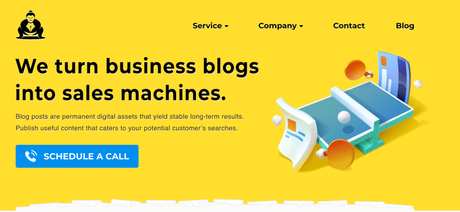Thank you for coming to my blog James! First off, please tell us about your business, Content Powered, and how you got your start?
Thank you! I come from an internet marketing and web development background. I first worked at a marketing agency and quickly rose to become their Chief Marketing Officer. I left to start my own eCommerce business, which was grown solely through blogging. After having success there, I started having clients ask me who was doing my blog posts and if I could help with theirs.
I quickly realized what a strong demand there was for top-tier blog content, and that nobody else was growing blogs quite like our team was. Thus, Content Powered was born.
1. What is the most common mistake that you see corporate blogs make?
Without a doubt, writing blog posts around poorly researched topics.Many bloggers just think of what to write off the top of their head, but you have to be a bit more calculating and analytical about topic ideation. Otherwise, you're just guessing. Identifying high traffic keywords, checking the competition, writing outlines, crumpling it all up and starting from scratch - this is what's necessary to make every blog post a success.

2. What is your biggest challenge when working with new clients?
Managing expectations and educating.Most business owners know that they need to be blogging, but beyond that, many aren't aware of how long it takes to succeed and what to expect long-term. We lose a lot of leads after letting people know that blogging is a building process that takes years of hard work. Compared to the instant gratification from pay-per-click ads like Facebook Ads, blogging requires patience and understanding of the long-term payoff.
3. What is one thing all corporate blogs could start doing today to improve their results?
Improve your topic ideation. Think about what your potential customers are searching online, even if it's only tangentially related to your business.
An example I like to use is, imagine you're a beach ball company. Writing an article titled "How to Perfectly Pack a Cooler for The Beach" will attract visitors that are more than likely people that go to the beach; your potential customers. It has decent search volume and low competition.
"But I'm not selling coolers!", a corporate client might say. That's perfectly okay. You're writing valuable content for your target audience, and when they're on your site learning the right way to pack their beach cooler, they may take an interest in your unique beach products. After all, they're already planning a trip to the beach and likely live close to one.
4. Is it safe to say you mostly work with corporations who use their blog as a marketing tool?
Yes, that's an important distinction to make.Some businesses only want to blog about their own products or company, and anything else will go against their brand image.
Blogging would probably not be a good fit for those businesses.
If a company uses their blog for news or announcements, it could be a good idea to move that to a separate section of their site called "News". We see businesses all the time with two different sections on their site, "News" and "Blog", which is perfectly fine. I think that's better than confusing the two.
A good example of this is on Expedia.com; their blog section is called "Viewfinder", while their news section is called "Newsroom". Their blog is filled with useful articles for travelers, and their newsroom is primarily company news and updates. Which one do you think gets millions of visitors per day from search engines? Their blog.
5. What is the most unique thing you've seen from all the corporate blogs you've worked with?
I think scrolling sidebars are clever.If your call to action scrolls with the user as they read the blog post, it's in their field of view the whole time. As long as it's a small enough container and it isn't obnoxious, it is very effective and safe for SEO.
I've also seen people combine this strategy with a script that makes their call to action button wiggle, flip, or otherwise move for a split second every 30 seconds to catch your eye. It's very subtle, and you might even miss it, but it does catch your eye as you're reading and improves your click-through rate.
6. For a company without a blog, what is one tip you'd give them to get started?
If you're hiring in-house, one person isn't enough. Running a blog properly requires a talented blog writer, an editor, an SEO expert, a content marketer, a graphic designer, and a web developer.
I see companies all the time trying to hire one person full-time to manage the blog, with a job title like "Content Marketing Specialist" or "Blog Manager", but it's almost impossible to find someone who is an expert in all of those things. It's just too much for one person.
7. What does your ideal blogging client look like?
Patient and committed to long-term growth. Our clients who understand the long-term benefit and return on investment of blogging never want to let us go! Our number one goal every month is to make as big of a splash as possible with our client's marketing dollars.
8. What parting advice do you have for business owners with corporate blogs?
Stick with it, hire smart people, and focus on quality over quantity. If you're carefully planning out and researching blog topics, posting on a consistent basis, and trying to make every blog post the very best version of that post on the internet, then you are already miles ahead of your competition.


